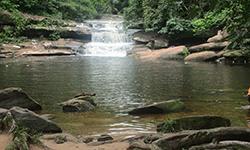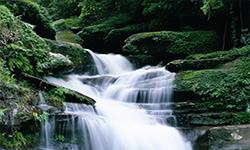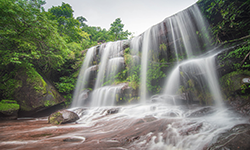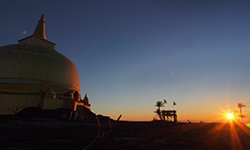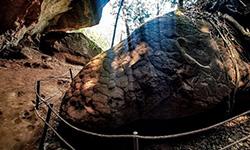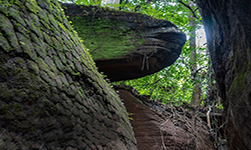Phu Langka National Park
Contact Location : Phu Langka National Park, Phai Lom Sub-district, Ban Phaeng District, Nakhon Phanom Province 48140
Telephone Number : (+66) 4 253 0766
Email : Plk.np2566@gmail.com
Facebook : Phulangka National Park Thailand
Information
-
Background
Mr. Maitree Anukulruangkitti, Forestry Officer, Level 3 of the National Park Division, submitted a note dated April 27, 2527 to the Director of the National Park Division, together with a survey report on the area of Phu Langka Forest, located in Ban Paeng District, Nakhon Phanom province, according to the Royal Forest Department Order No. 55/2527 dated January 12, 1984, which ordered him to explore and establish a forest park. Mr. Maitree reported that there was an appropriate condition to be established as a forest park.
Because the Phu Langka Forest area which was surveyed has an area of approximately 31,250 rai, or about 50 square kilometers, covering the areas of Ban Phaeng District, Nakhon Phanom Province, and Seka District, Nong Khai Province generally are hill evergreen forest, tropical evergreen forest, mixed deciduous forest, and deciduous dipterocarp forest, all of which are fertile, have abundant wildlife, are the origin of several streams, and have natural features such as cliffs, caves, and waterfalls, which are within the criteria that can be established as a national park. Furthermore, it is in response to the government's policy on the conservation of forest areas in the form of a national park. Therefore, it was appropriate to establish the area of Phu Langka Forest, Ban Phaeng District, Nakhon Phanom Province and Seka District, Nong Khai Province as a National Park and considered that it is appropriate to recruit officials to act as the National Park Superintendent so that the proceeding could be run effectively.
The Royal Forest Department has issued an order 642/2539 for government officials to perform official duties dated April 1, 1996, and assigned Mr. Watcharin Piyasuth, forest officer, Level 5 of National Park Division, Natural Resources Conservation Office, to serve as an superintendent of Phu Langka National Park. Also, there was a further exploration of additional areas to be established as part of Phu Langka National Park in accordance with Section 6 of the National Park Act 1961.
Such areas are Phu Langka National Reserved Forest which was issued under the National Reserved Forest Act, 1964. The area is approximately 44,031 rai (70.4496 square kilometers) but has been encroached and the remaining area is approximately 31,250 rai, or about 50 square kilometers. Within the remaining, there are fertile forest conditions,a source of the watershed, many kinds of wild animals, beautiful natural attractions, biodiversity and environment diversity. The territory on the north bordering with Sai Creek and San Creek which are in the areas of Dong Bang and Pho Mak Khaeng Sub-district. Bueng Khong Long District, Nong Khai Province. The south borders with the wagon way paved by cows and buffalos, and farming areas of people which are part of Phon Thong and Nong Son Sub-district, Ban Phaeng and Na Thom District, Nakhon Phanom Province. The east borders with farming areas of people, which are part of Na Ngua and Phai Lom Sub-district, Ban Phaeng District, Nakhon Phanom Province. The west borders with the people's farming land, which are part of Pho Mak Khaeng Sub-district, Bueng Khong Long District, Nong Khai Province.
The Royal Forest Department has considered conserving forest resources and beautiful natural scenery to maintain the natural balance of the ecosystem in the area in the form of a national park for the benefit of education and the enjoyment of the people. Therefore, the areas should be designated as a national park in accordance with Section 6 of the National Park Act 1961.
Note : After paying the entrance fee to the National Park, please carry the receipt for inspection.
31250.00 rai (50 square kilometers)
|
|
|
||
|
|
|
||
|
|
|
||
-
Welfare shop : 08.00 - 17:00 hrs.
Mobile phone signal:
National Park Headquarters area: AIS, TRUE
|
|
It is characterized by several rows of mountains, namely Phu Langka Nuea, Phu Lanka Klang, and Phu Langka Tai, stretching along the north to south, interspersed with several small complex mountain ranges, stretching along the Mekong Stream. Its highest point is on Phu Langka Nuea, 563 meters above mean sea level. The general condition of the areas is the sandstone mountains. .The important rock layers are divided into 3 categories, which are Khorat Rock Group, Phu Phan Rock Group, and Phu Kradueng Rock Group. The soil characteristics are sandy soil with moderate erosion. Phu Langka is the origin of many streams such as Sai Nuea Creek, San Creek, Yang Nok Ho Creek, Lanka Creek, Kham Creek, and Sai Tai Creek, which are very important for the people the nearby plains of the district for agriculture and flow into the Mekong River in the Ban Phaeng District, Nakhon Phanom Province. The geology and geological structure: The geological structure of Phu Langka National Park is a Khorat Rock Group consisting of 2 formations as follows: 1) The Phu Phan Fornation is a Cretaceous geologic formation, mixed with white and yellow and brown sandstone, and sandstone mixed with gravel and interspersed with shale. 2) The Phu Kradung Formation originated in the Jurassic period, mixed with brown sandstone. and reddish brown. Water resources: In terms of quality classification, the watersheds within Phu Langka National Park mostly consist of watershed class 1A, representing 39.13 percent, followed by watershed class 2, covering the park's area, accounting for 26.21% Characteristics of the canals in Phu Langka National Park are mostly short/long canals that flow in the direction from north to south, consisting of Huai Sai, Huai Yang Nok Ho, Huai Lanka, Huai Laeng, and Huai Mafai which are formed by Tat Pho Waterfall and flow into the Mekong River. |
|
The climate is generally similar to other areas of the northeast. The environment on the top of the mountain will look like a rock. Winter is very cold, about 0-5 degrees Celsius, with an average temperature all year around 25-36 degrees Celsius. The rainy season has a lot of water, about 1,860 millimeters per year.
|
|
|
|
The area of Phu Langka National Park is covered with dry evergreen forest, mixed deciduous forest, and deciduous dipterocarp forest. Wild flowers are found in general, especially wild orchids, including Lady's Slipper, and at present Dendrobium. and Doritis pulcherrima are mostly found. In addition, Phu Langka is also a source of various herbs. Wildlife in Phu Langka as found today and from the information gained from the villagers, it was found that there are many mammals such as wild boars, monkeys, Asian palm civet, and barking deer, squirrels, chipmunks, and marmots, and there are also many types of birds Other prominent animals are reptiles including Himalayan Newt and many kinds of snakes.
|
How to get there by car :
Phu Langka runs parallel to National Highway No. 212 (Nakhon Phanom-Ban Phaeng-Nong Khan) for about 105 kilometers and far from Nong Khai Province for 220 kilometers, farm from Ban Phaeng District for about 6 kilometers. Traveling to Phu Langka is comfortable in all seasons. If starting from Bangkok, visitors can take several routes: Bangkok-Udon-Phang Khon-Wanon Niwat-Seka-Ban Phaeng or take the route Bangkok-Sakon Nakhon-Nakhon Phanom-Ban Phaeng.
- National Park Ranger Station Pho Ko No. 1 (Namtok Tat Kham)
-


